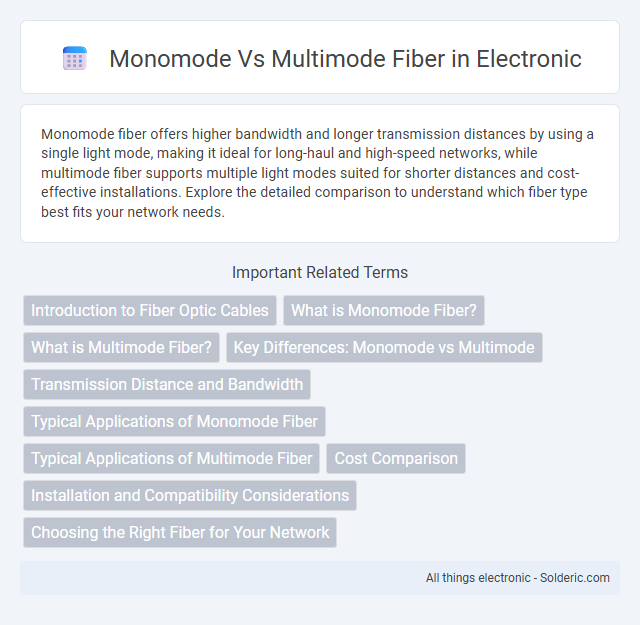Monomode fiber offers higher bandwidth and longer transmission distances by using a single light mode, making it ideal for long-haul and high-speed networks, while multimode fiber supports multiple light modes suited for shorter distances and cost-effective installations. Explore the detailed comparison to understand which fiber type best fits your network needs.
Comparison Table
| Feature | Monomode Fiber | Multimode Fiber |
|---|---|---|
| Core Diameter | 8-10 microns | 50-62.5 microns |
| Light Mode | Single mode | Multiple modes |
| Transmission Distance | Up to 40 km+ | Up to 2 km |
| Bandwidth | Higher bandwidth capacity | Lower bandwidth capacity |
| Laser Type | Laser diode (LD) | LED or Vertical-Cavity Surface-Emitting Laser (VCSEL) |
| Cost | Higher initial cost | Lower cost |
| Applications | Long-distance telecommunication, data centers | Short-distance LANs, data centers |
Introduction to Fiber Optic Cables
Fiber optic cables transmit data through light signals, with monomode fibers designed for single light paths and longer distances, while multimode fibers support multiple light paths suitable for shorter distances. Monomode cables offer higher bandwidth and lower attenuation, making them ideal for telecommunications and long-haul networks. Your choice between monomode and multimode depends on distance, bandwidth requirements, and application environment.
What is Monomode Fiber?
Monomode fiber, also known as single-mode fiber, uses a small core diameter of about 8-10 microns to allow only one light mode to propagate, minimizing modal dispersion and enabling high-bandwidth data transmission over long distances. It is ideal for telecommunications, long-haul networks, and high-speed data links due to its low attenuation and greater transmission capacity compared to multimode fiber. If you require future-proof performance and minimal signal loss for your network infrastructure, monomode fiber is the superior choice.
What is Multimode Fiber?
Multimode fiber is an optical fiber designed to carry multiple light modes or rays simultaneously, making it ideal for short-distance data transmission within buildings or campuses. It has a larger core diameter, typically around 50 to 62.5 microns, allowing multiple light paths but resulting in higher modal dispersion and lower bandwidth compared to single-mode fiber. Common applications of multimode fiber include local area networks (LANs), data centers, and audio/video communication systems where cost-effective, high-speed connectivity over moderate distances is required.
Key Differences: Monomode vs Multimode
Monomode fiber uses a single light mode to transmit data, enabling higher bandwidth and longer distances up to 40 kilometers or more, making it ideal for long-haul telecommunications and data centers. Multimode fiber supports multiple light modes, which limits its effective range to about 500 meters and reduces bandwidth, but offers lower cost and easier connectivity for short-distance applications such as LANs and data communication within buildings. Core diameter in monomode fibers is typically around 8-10 microns, whereas multimode fibers have larger cores, approximately 50-62.5 microns, directly impacting modal dispersion and overall signal quality.
Transmission Distance and Bandwidth
Monomode fiber offers significantly higher transmission distances, reaching up to 40 kilometers or more, due to its single light path that minimizes signal attenuation and modal dispersion. Multimode fiber supports shorter transmission distances, typically up to 550 meters, but provides sufficient bandwidth for data rates up to 10 Gbps in local area networks. Choosing between monomode and multimode fiber depends on Your network requirements for distance and bandwidth capacity.
Typical Applications of Monomode Fiber
Monomode fiber is predominantly used in long-distance telecommunications, high-speed data networks, and fiber-optic internet services due to its ability to transmit signals over vast distances with minimal signal loss and high bandwidth capacity. It is ideal for undersea cables, metropolitan area networks (MANs), and cable television distribution where precision and reliability are critical. Your infrastructure benefits from monomode fiber when requiring robust performance in high-data-rate applications spanning several kilometers.
Typical Applications of Multimode Fiber
Multimode fiber is commonly used in data centers, LANs, and short-distance communication networks due to its cost-effectiveness and ability to handle high data rates over distances typically up to 550 meters. Its core size allows multiple light modes to propagate, making it ideal for applications such as video surveillance, audio/video signal transmission, and intrabuilding connections. Your choice of multimode fiber supports efficient, high-bandwidth communication within campuses or office buildings where long-distance signal transmission is not required.
Cost Comparison
Monomode fiber typically incurs higher initial costs due to its precise manufacturing and specialized laser sources, making it more expensive than multimode fiber. Multimode fiber offers lower installation and component costs, suitable for shorter distances and budget-conscious applications. Your choice depends on balancing upfront expenses with long-term performance needs and network scalability.
Installation and Compatibility Considerations
Monomode fiber requires precise alignment and specialized equipment for installation due to its smaller core diameter, making it ideal for long-distance, high-bandwidth applications. Multimode fiber offers easier installation and compatibility with a variety of transceivers, supporting shorter distances and lower costs, commonly used in data centers and enterprise networks. Compatibility issues arise as monomode and multimode fibers are not interchangeable without media converters or mode-conditioning patch cords, impacting overall network design and maintenance.
Choosing the Right Fiber for Your Network
Selecting the right fiber type depends on network distance and bandwidth requirements, with monomode fiber offering high-speed, long-distance transmission ideal for telecommunications and large-scale enterprise networks. Multimode fiber suits shorter distances and cost-effective installations, making it optimal for data centers and LAN environments due to its larger core diameter and multiple light paths. Evaluating factors like signal attenuation, modal dispersion, and overall cost efficiency ensures optimal performance and future-proofing for your network infrastructure.
Monomode vs Multimode fiber Infographic

 solderic.com
solderic.com